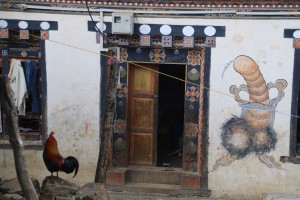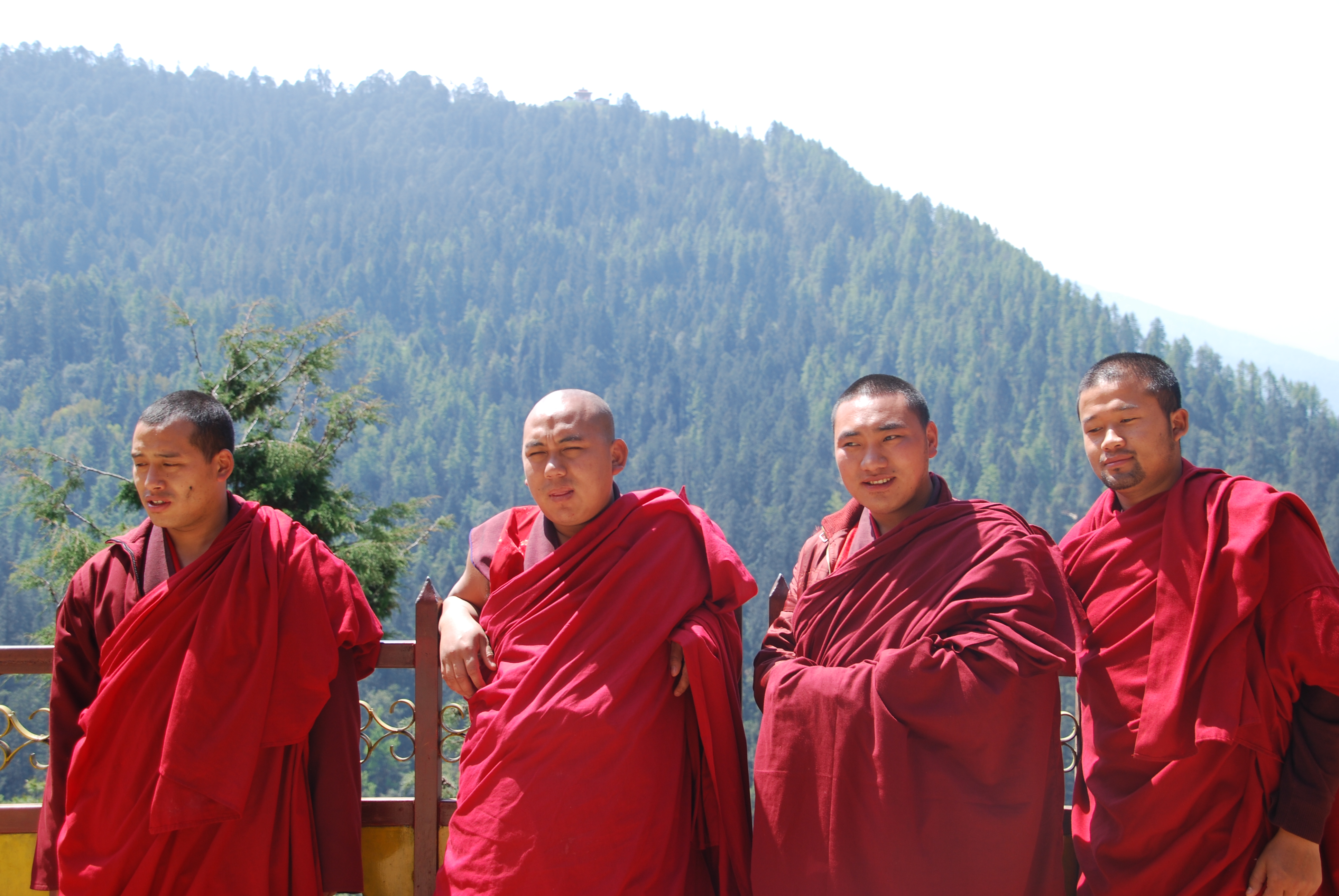Fluent in Goembas and Dzongs
Bhutan is known for two main features – its magnificent mountains as part of being totally consumed by the Himalayas and its fervent belief in Buddhism. We had the opportunity to combine both of these features in a spectacular morning trek to the Tango Goemba a bit north of the capital of Thimphu and we were rewarded with one of the best experiences in ages. And by donating to the temple in the monastery and receiving scented holy water we were guaranteed good karma for the rest of the day.
The track to the hidden monastery was endlessly uphill, a series of switchbacks which climbed through the beautiful blue pines, past scattered rhododendrons and up into unexpected oaks which featured moss on their trunks and branches. But this was a relentless climb straight up, its only relief being the forest we passed through and the glimpses of the valley below. After a climb of an hour and an altitude gain of about 400 metres we breathlessly hit the monastery which was perched on the steep mountain side at about 2900 metres.
The history of Tango Monastery is long and varied but it was founded in the 12th century, massively built up in the 16th century and carefully renovated last century. It is precariously placed on a steep face of the mountain but spectacular in its high thick walls and traditional architecture. It is hard to imagine what this remote place would have been like 500 years ago but for the monks and lamas – or religious heads – that lived here it must have been supremely peaceful.
We had the unique opportunity of shimmering up the crammed narrow steps in the cliff-side cave to spend a moment in the original place of prayer for resident monks all those years ago. It was a rare and special privilege, even if the precipitous cliff-hugging position and cramped quarters pushed us back down again.
After this numbing exposure to the very core of Bhutanese buddhism we headed down the winding dirt path and road back to Thimphu for lunch and then drove to the Trashi Chhoe Dzong. A dzong (don’t bother pronouncing the d) is a fortress which in the 12th to 16th century included the King’s quarters, the army and the monastery. In other words, it was huge and the dzong in Thimphu is absolutely massive. Huge thick walls, imposing guard towers, spacious courtyards, numerous buildings in original Bhutanese architecture and a beautiful colourful temple are what defines this ancient city within walls.
We wandered through the open spaces wondering what it must have been like to live here in the 16th century in such a grand setting. And still to this day the much loved King walks from his modest palace nearby into the administrative section of the dzong to go about his daily duties. So in short, this is still where its at!
We also visited the Zilukha Nunnery where amins, or female nuns, live and worship. We went inside their small temple where they were mesmerisingly chanting and banging their prayer drums in unison. As a bit of contrast, we then drove up the mountain to a little zoo where the city keeps a healthy collection of barking deer, sambar deer and the national animal of Bhutan – the takin. The takin are officially a unique species referred to as a goat antelope but mythically are said to be a cross between a goat and a yak. In any case their head and body and legs are oddly out of proportion and they look a bit photoshopped. Unfortunately this rather bizarre creature is now only found in Bhutan and apparently in very small numbers.
We spent a great night in the town, first having a drink or two at a very local bar and then dining as the only guests in a nearby restaurant where we ate a number of delicious local treats, including trying one of their national dishes called ema dashtri. This concoction is basically full chilies cut long way, add onions, simmer for a moment and cover in melted cheese. There was absolutely no subtlety about this dish, it was tasty but firetruck hot; we bravely dug in.
Each road trip has to have a ‘longest day’ and we left Thimphu early the next morning to begin ours. But it wasn’t the distance that would eventually mean a nine hour day on the road because we only covered about 200 kms all up. The biggest factor – and feature – of the day was the road we were to travel which is promisingly called the National Highway and is the only road connecting western and eastern Bhutan. But what a road it is!
Never has the term ‘National Highway’ been more relevant and more amusing. The road quickly wound its way up the mountain east of Thimphu to the Dochhu La Pass at 3080 metres. Most of the road was narrow and in poor condition as it hugged the mountainside but luckily Bhutanese drivers keep the speed down and everything seems to work okay, even when passing a huge truck on a narrow turn without guardrails.
Dochhu La Pass features 108 square chortens, or stupas in Bangkok language, which are delightfully positioned to take in views from all directions and surrounded on the nearby slope by thousands of prayer flags. It was a beautiful and peaceful setting but we did have to pull out an extra layer for the first time as the temps had dropped noticeably.
From the pass we sunk down into the next valley, mist and cloud hiding most of the steep forest-covered mountains around us. The variety of trees were stunning, including oak (with long hanging moss), chestnuts, cherry pine (so named for their small round cone), wild jacarandas, cacti blooming with beautiful yellow flowers (yes!), the large and foreboding hemlocks and the national tree Cypress. But the standout tree was the rhododendrons and even though we were a little late for the season we saw beautiful blooms of pink, red and white etho metho, as the locals call them. We might have taken a few photos.
The road deteriorated to a single narrow lane, reminiscent of when the Indians built it in 1970 just wide enough to handle a jeep. In many long sections the bitumen was completely gone and it bordered on a four wheel drive track. The problem, our guide Taupo told us, was the huge trucks, mainly from the quarry sites, whose heavy loads ruined the road. But clearly huge landslides, erosion, harsh winters and poor construction all play their hand in a road which contained thousands, if not tens of thousands, of sharp bends as it cut its way along virtually vertical mountain faces. An engineering feat, yes, but as the only road connecting this dramatically mountainous country it also is a major economic challenge.

A home in the village of Nobding with some unusual wall paintings to bring them good luck and happiness
We arrived in the mountain village of Nobding which featured a number of buildings painted with huge phallic symbols (modesty prohibits me from being more graphic) and a superb Bhutanese lunch. From there we climbed more mountains on desperately narrow roads to Pele La Pass which topped out at 3,400 metres. This was the highest Julie had ever been and she was greeted with a cold biting drizzle and low clouds which blocked the views to 7,000 metre mountains all around us. With the help of Taupo we ceremoniously hung our long string of prayer flags, which was a very cool experience, and watched hairy yaks, king of the high altitudes in the Himalayas, grazing near us.
More gripping turns down the next valley with stunning views of the raging river far below us until we came to the Chendebji Chorten, a 19th century stupa built in the Nepalese style with those lovely all seeing eyes painted in all four directions. We stretched our legs and wandered the grounds of the beautiful peaceful setting.
The road continued as before, scarily carved into the cliff face, defying the usual safety standards and keeping the heart beating at cardio levels. Julie and I could not believe the views of the mountains around us with the Bhutanese farm houses clinging to the slopes and finding a few unlikely spots to build terraces for planting rice and barley.
Eventually we stopped at a chortern for a spectacular view across the valley at the 16th century Trongsa Dzong, built at the exact middle point of the country and guarding the only passage between east and west. With a long drive down and around the valley we finally arrived at our hotel for the night, perched on the hillside and sporting stunning uninterrupted views of the dzong from our balcony. Only two things dented this surreal moment in the middle of Bhutan – the lack of power at our hotel which prompted a rare candle light dinner for Julie and I, and a group of 12 Russian touring motorcyclists who dominated social proceedings. You get the whole package in Bhutan.
























